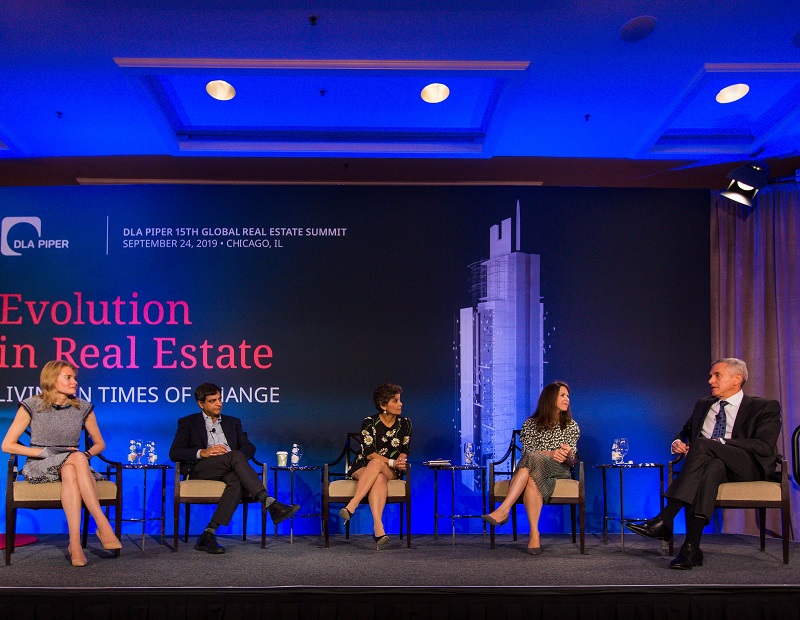The Struggle Between Capital and Interest Rates
At DLA Piper Summit's plenary session, industry veterans from Allianz Real Estate, Blackstone, USAA, Brookfield and Ventas reflected on the relationship between shrinking interest rates and the trainloads of capital looking for suitable opportunities.

(Left to right) Karen Horstmann, Sandeep Mathrani, Debra Cafaro, Kathleen McCarthy and Len O’Donnell. Image courtesy of Michelle Weeks
The plenary session at DLA Piper’s 15th Global Real Estate Summit, titled “Real Estate in a World of Disruption and Uncertainty,” addressed a wide range of topics during more than an hour of spirited discussion. During the panel, the moderator and four panelists touched on the collision between low-to-negative interest rates and a “wall of capital” waiting to get into commercial real estate. The ever-more-rapid obsolescence of product in multiple CRE sectors was also on the agenda.
Moderator Karen Horstmann, head of acquisitions at Allianz Real Estate of America, started off with a lightning round, asking the panelists what keeps them up at night and what are they most excited about. Kathleen McCarthy, global co-head of real estate at Blackstone, admitted her concern over global populism and what that means for real estate, particularly in housing.
High allocations, lower expectations
Horstmann sketched out the low-interest-rate state of the economy, with an estimate from Bloomberg that negative-interest-rate holdings total $17 trillion. She added that the U.S. 10-year Treasury notes have been at less than 3.25 percent for the past eight years, LIBOR is expected to remain between 1 and 2 percent, and the Fed is expected to cut rates again, all while growth remains low.
Len O’Donnell, president & CEO of USAA Real Estate commented, “I have come around to the view that we are in this low-interest-rate environment for the long haul.” Many central banks function as arms of their respective governments, he explained, and with slow- or negative-growth economies and shrinking populations, “there’s simply no incentive to push interest rates up and there’s no growth to support the need for it. We’re really in negative real interest rates in the U.S. right now, and I think that’s something we don’t focus much on.”
See our full coverage of the 2019 DLA Piper Global Summit
However, O’Donnell sees less volatility going forward in the industry that he refers to as “relatively mature.” “I think there has to be an industry-wide shift in how people are incentivized and how they’re compensated in a nominal-return world.”
Horstmann noted the considerable amount of capital waiting to be deployed into real estate. “Real estate allocations broke the 10 percent barrier last year,” yet “investors generally remain 90 to 100 basis points under-invested in real estate,” she said. There’s an estimated $340 billion in dry powder and that total is growing steadily.
Based on that, she asked the panelists if investors need to lower their expectations regarding returns. Debra Cafaro, chairman & CEO of Ventas Inc., noted that structural factors in the U.S. economy, including demographics, are leading to lower growth and added that “Return expectations have definitely come down.”
Times, properties are changing
In response to Horstmann’s question on where to find pockets of growth, Sandeep Mathrani, CEO of Brookfield Properties Retail Group, observed that there is obsolescence in every industry and that the solution is to stay ahead of the curve. “In our industry, we overbuild and we under-demolish,” he said, then cited an example of putting one’s money where one’s mouth is.
Brookfield will be deploying almost $300 million of capital to reconfigure its upscale Northbrook Court mall in suburban Chicago, demolishing roughly half of it and adding 315 apartment units, a food hall and a 70,000-square-foot grocery store. “This is a shopping center that has the demographics, it has a Nieman-Marcus … but it doesn’t work,” Mathrani said. “We could sit here, do nothing and watch traffic go to zero or do something and make a billion dollars. You need that courage to recognize obsolescence and do whatever is appropriate for the asset.”
READ ALSO: Retail Sector Makes Headway in Experiential Drive
“It’s sort of fun to beat up on malls,” O’Donnell quipped. But except (maybe) for logistics, “Everything is becoming more experiential. Corporate America wants buildings that help them compete in the war for talent, that are heavily amenitized.”
Apartments have almost become like the hotel business, he continued. “If we’re not doing a refresh every five years, that apartment building looks like it’s 20 years old.” O’Donnell concluded that all asset types are becoming obsolete faster and that malls have become the poster child for the phenomenon.
Cafaro commented that a balanced approach often works best. “You really don’t have to be a visionary to do well. In many cases, if you get too far out in front, you fail.”
Takeaway trend creates opportunities
Since the financial crisis, McCarthy said, Blackstone has bought nearly 1 billion square feet of logistics space worldwide, though this has more recently focused specifically on last-mile facilities. Retailers’ transportation costs far outweigh their real estate costs, by perhaps an order of magnitude, she explained, “so there is room for rents to increase, especially in those closer-in locations in urban areas with very limited new construction.” In addition, more and more users are looking for last-mile locations, including kitchens specifically for delivery food.
Walmart and other retailers are focusing on being their own last-mile providers through the buy-online, pick-up-in-store model, Mathrani added. Even some restaurants are starting to follow a similar pattern, he said. “You don’t need 400 seats any more in a restaurant, you need 100 seats,” because there’s so much takeout.







You must be logged in to post a comment.